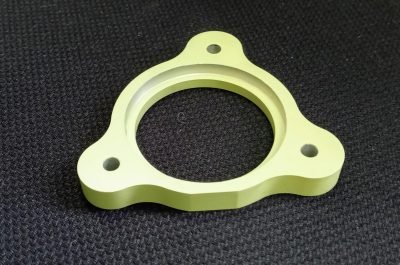Conductivity Testing for Aerospace Parts
As an AS9100-certified aerospace and defense manufacturer, we make it our business to offer services critical to the functionality and safety of all of our customers’ aircraft, whether we’re providing those services under our own roof or via a trusted vendor in our extensive network.
One service we are now thrilled to offer is conductivity testing—also known as eddy current testing. A non-destructive testing method that uses electromagnetism to detect flaws in conductive materials, conductivity testing reveals points of variation in current level and points of permeability within conductive parts.
Why Is Conductivity Testing Important in AS9100 Machining?
Determining the level of current that flows through a part is key to ensuring aircraft functionality and safety.
Like hardness testing, conductivity testing helps aerospace manufacturers ensure that a part meets critical specifications to guarantee proper form and function.
For instance, a commercial aircraft must be protected from electric current in the event that it is struck by lightning. While cosmetic damage to the plane’s external parts will not compromise its functionality, deeper penetration by electricity will. If lightning discharges its current into an aircraft with highly conductive parts, the aircraft will burn, endangering its passengers.
Special Considerations for Conductivity Testing
Some precision machining and finishing processes can affect a part's conductivity. Here are a couple of special considerations to keep in mind to obtain the most accurate results:
Beware of potential material mixing
A CNC machine shop that manufactures aircraft parts from stainless steel or aluminum may also make parts for other applications using hyperconductive materials such as copper. If the machines are not cleaned properly between jobs, material mixing can occur, and the part will take on added conductivity.
Performing conductivity testing after precision machining allows manufacturers to determine whether parts have been contaminated by traces of conductive metals.
Apply finishing treatments before testing
A finishing treatment such as anodize should always be applied prior to conductivity testing, as the anodizing process reduces conductivity. The conductivity test will still be able to detect any flaws in the metal surface underneath the anodize layer.
How Conductivity Testing Works
Now, let’s dive even deeper into how conductivity testing works. A conductivity test has three components:
Test instrument
Test probe
Reference standard: ASTM B193
Our customers provide us with a part drawing or spec sheet indicating the required conductivity for a part (i.e., the range per ASTM B193). Currently, we’re receiving many requests to test to a particular aerospace company’s specification, and we’re working with one of their approved suppliers to manage conductivity testing.
The test itself uses electromagnetic induction to reveal variations in conductivity due to cracks, dents, or traces of conductive metals on the part’s surface. The process begins when alternating current passes through a conductor, such as a copper coil, creating an alternating magnetic field around the conductor. When the test probe approaches another conductor, an eddy current is triggered within the magnetic field.
This current is then opposed by a secondary magnetic field issuing from the eddy current. Changes in the magnitude of the eddy current—as reflected in one of the two conductors—enable the tester to measure variations in conductivity and determine whether a part complies with the ASTM B193 specification for a given application.
Your One-Stop Shop for AS9100 Machining
Alard Engineering is committed to being your one-stop shop for AS9100 machining. In addition to seamlessly managing outside processes like conductivity testing, we’re proud to offer in-house processes like non-destructive testing, powder coating, and heat treating. We welcome any opportunity to broaden our services to meet our customers’ needs as quickly and efficiently as possible.
Request a quote today!


